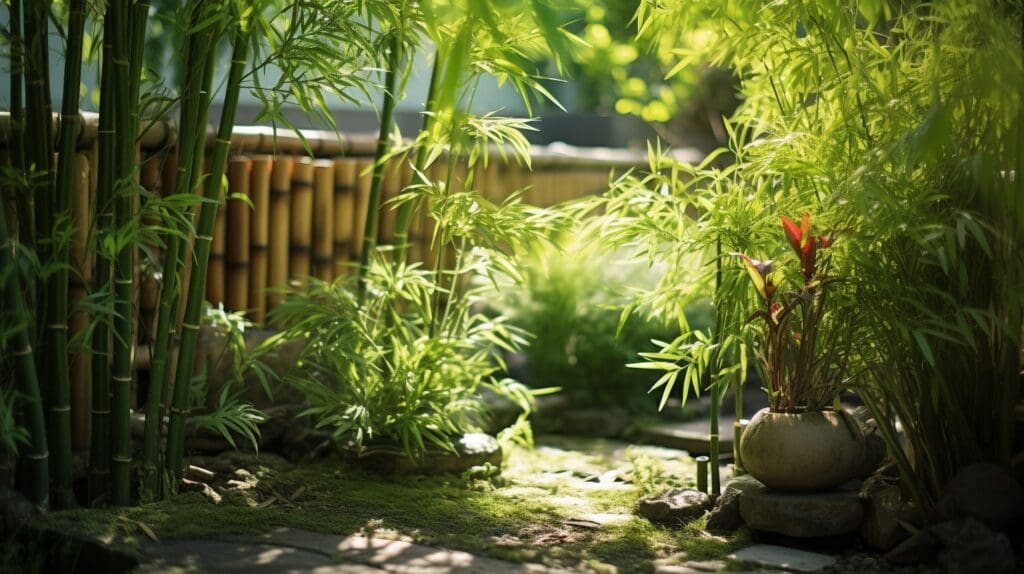Looking to add some greenery to your shaded garden? Wondering if bamboo can thrive in shade? Good news! Bamboo can indeed grow in shade, but it’s important to choose the right shade-tolerant species and understand the factors that affect its growth.
Factors That Affect Bamboo Growth in Shade
While bamboo is generally known for its ability to thrive in full sunlight, some varieties can tolerate partial shade.
One important factor to consider is the amount of shade the bamboo plant will receive. Bamboo requires at least some direct sunlight to grow properly. If the shade is too dense, it can hinder the plant’s growth and weaken its overall health.
Another factor to consider is to ensure the soil is suitable. Bamboo prefers well-drained soil that retains moisture but doesn’t become waterlogged. Sometimes heavily shaded locations can be susceptible to the soil remaining sodden for extended periods.
However, providing adequate water and nutrients is crucial for bamboo growth in shade. Regular watering (but not over-watering) and fertilization will help the plant stay healthy and adapt to the lower light conditions.
How to Choose the Right Shade-Tolerant Bamboo Species
When selecting a shade-tolerant bamboo species, it’s important to research and compare different varieties to find the best fit for your garden. Start by considering the specific conditions in your garden, such as the amount of shade and the soil type.
Some bamboo species are more adaptable to shade than others, so it’s crucial to choose one that can thrive in low light conditions. Look for bamboo varieties that are labeled as shade-tolerant or shade-loving. The following table lists species that have reasonable shade-tolerance and worthy of further consideration:
| Species | Approximate Growing Height (feet) | USDA Hardiness Zone Range |
|---|---|---|
| Fargesia murielae | 6-10 | 5-9 |
| Fargesia nitida | 6-10 | 5-9 |
| Fargesia robusta | 10-15 | 5-9 |
| Fargesia rufa | 6-10 | 5-9 |
| Fargesia scabrida | 6-10 | 5-9 |
| Borinda fungosa | 10-15 | 7-9 |
| Borinda macclureana | 10-15 | 7-9 |
| Bambusa multiplex | 10-15 | 7-10 |
| Bambusa textilis var. gracilis | 15-25 | 8-11 |
| Himalayacalamus hookerianus | 10-15 | 7-9 |
Don’t forget to also consider the aesthetic appeal of the bamboo, as different varieties have different leaf shapes and colors.
Things to Remember for Growing Bamboo in Shade
Light is one critical factor for successful plant growth. But it is important not to forget about the other important factors. These include appropriate soil structure and composition, sufficient nutrients in the soil and adequate (but not excessive) water.
It’s important to prepare the soil properly by adding organic matter, such as compost or well-rotted manure. This will assist with soilstructure and composition, but also provide the plant with nutrients required for optimum growth. Supplmenting this over the longer term with top-up organic matter or slow release fertilizer will ensure the soil is not depleted to the detriment of the plant’s health.
Additionally, you should regularly monitor the moisture levels in the soil to ensure that it remains consistently moist, but not waterlogged. This can be achieved by watering the bamboo regularly and mulching around the base of the plants to help retain moisture.
Frequently Asked Questions
Can Bamboo Survive in Complete Darkness?
Bamboo can’t survive in complete darkness as it requires sunlight for photosynthesis. However, it can tolerate some shade and still grow.
Moderate shade is ideal for bamboo growth, but complete darkness would be detrimental.
What Are the Signs of Bamboo Not Receiving Enough Light?
If bamboo isn’t getting enough light, you might notice signs like yellowing leaves, stunted growth, and weak stems. It needs adequate sunlight to thrive, so make sure it’s getting enough exposure.
Can I Grow Bamboo Indoors in a Shaded Room?
Yes, you can grow bamboo indoors in a shaded room. Bamboo prefers bright light, but it can tolerate lower light conditions. Just make sure to provide it with indirect sunlight and monitor its growth.
Is There a Specific Type of Shade That Is More Suitable for Bamboo Growth?
There isn’t a specific type of shade that’s more suitable for bamboo growth. However, bamboo can still grow in shade as long as it receives some indirect sunlight throughout the day.
Bamboo is known for its ability to thrive in a variety of light conditions. While it generally prefers full sun, it can adapt to partial shade. In fact, some bamboo species actually prefer shade and can grow well in areas with limited sunlight.
When planting bamboo in a shady area, it’s important to ensure that it still gets some indirect sunlight. This can be achieved by choosing a location that receives dappled sunlight or by creating some shade breaks in a heavily shaded area.
It’s also worth noting that bamboo plants may grow taller and lean towards the light source when grown in shade. This is a natural response to seek out more sunlight. Pruning can help maintain a more upright growth pattern.
Overall, while bamboo can tolerate shade, it’s still important to provide it with some indirect sunlight for healthy growth. With the right conditions, bamboo can thrive even in areas with limited light.
Can Bamboo Grow in Areas With Fluctuating Levels of Shade Throughout the Day?
Yes, bamboo can grow in areas with fluctuating levels of shade throughout the day.
It’s a versatile plant that can adapt to different light conditions, allowing it to thrive even in changing shade.
Conclusion
So if you’re looking to grow bamboo in shaded areas, it’s definitely possible! Factors such as light intensity and duration, as well as the specific bamboo variety, play a role in its growth.
By choosing shade-tolerant bamboo species and providing proper care, you can successfully cultivate bamboo in shady spots. Just remember to monitor its growth and address any challenges that may arise.
Happy bamboo gardening!

